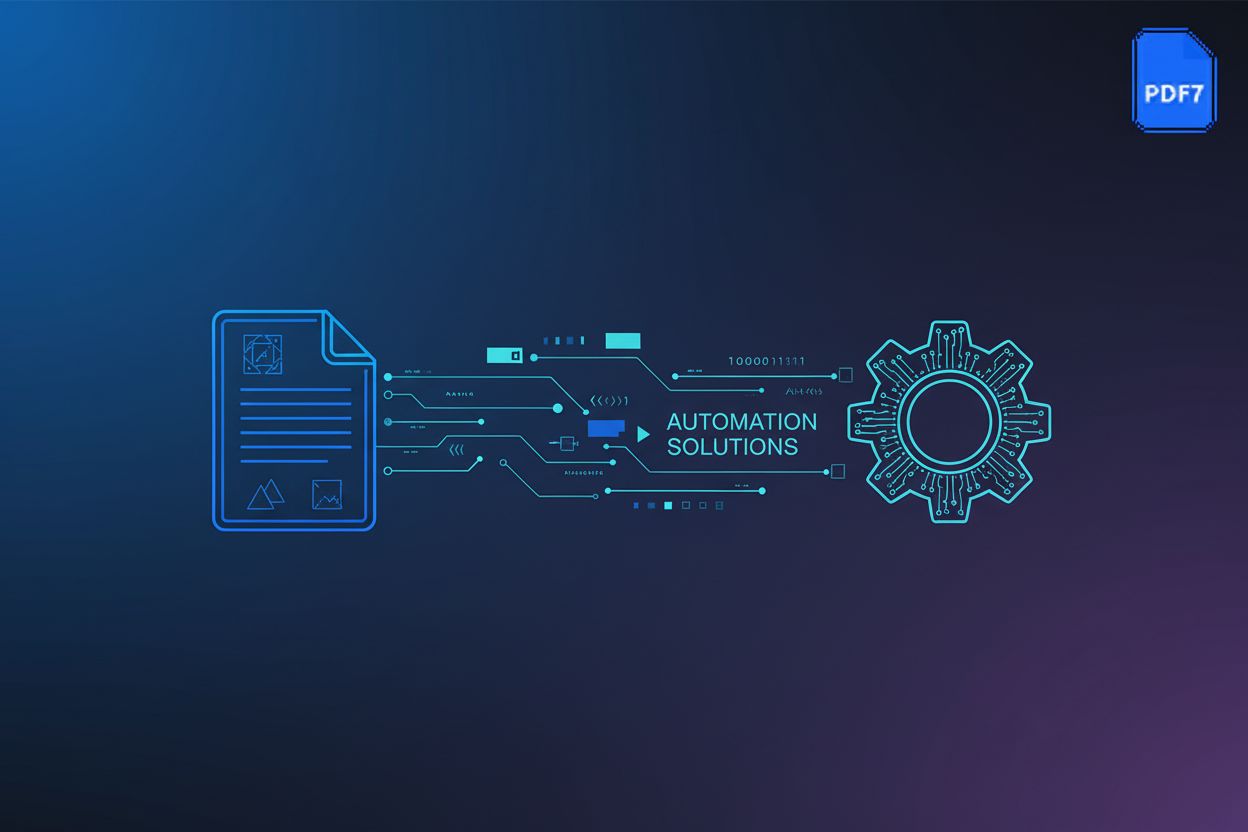Mastering PDF Optimization: A Comprehensive Guide for Students and Professionals
Understanding PDF Optimization
Did you know that a poorly optimized PDF can be up to ten times larger than necessary? This inefficiency leads to slower downloads, wasted storage space, and a frustrating user experience. Let's explore how to avoid these issues.
PDF optimization is the process of reducing the file size of a PDF document without significantly compromising its visual quality or functionality. It involves techniques like compressing images, removing redundant data, and streamlining fonts. The goal is to strike a balance between file size and usability.
- For example, in healthcare, optimizing PDFs ensures that large medical reports can be quickly shared between doctors and patients without exceeding email size limits.
- In finance, optimized PDFs allow for the efficient distribution of quarterly reports and statements, saving bandwidth and storage costs.
- Even in retail, optimizing product catalogs can lead to faster loading times on e-commerce platforms, improving the customer experience.
Optimizing PDFs offers several key advantages for both students and professionals. Faster email attachments and uploads are obvious benefits. Reduced storage space translates to lower costs for businesses and more room on personal devices.
- Faster email attachments and uploads: Smaller file sizes mean quicker sending and receiving, especially crucial for professionals dealing with tight deadlines.
- Reduced storage space: Optimized PDFs take up less space on hard drives and cloud servers, saving money and improving efficiency.
- Improved website loading times: Optimized PDFs load faster when embedded on websites, leading to better user engagement.
- Enhanced mobile viewing experience: Smaller PDFs are easier to view and navigate on smartphones and tablets.
Several factors can contribute to unnecessarily large PDF file sizes. Identifying and addressing these issues is the first step in effective optimization.
- High-resolution images: Images with excessively high resolutions can dramatically increase file size.
- Embedded fonts: Embedding entire font families, rather than just the characters used, adds extra bulk.
- Transparency effects: Complex transparency effects can hinder compression efforts.
- Unnecessary metadata: Metadata like author information and creation dates can be stripped without affecting the document's content.
- Inefficient compression algorithms: Using outdated or inefficient compression methods results in larger files.
Understanding these core concepts sets the stage for diving into specific optimization techniques. The next section will explore practical methods for reducing PDF file size.
Core Optimization Techniques
Did you know that PDFs often contain hidden bloat that significantly increases file size? Let's explore techniques to trim the fat.
Image compression reduces file size by eliminating unnecessary pixel data. You can choose between:
- Lossy compression (JPEG, JPEG 2000) which removes some data for smaller files. This is great for photos where a slight loss of detail is unnoticeable, but it's not good for graphics or text where clarity is key.
- Lossless compression (ZIP, JBIG2) which preserves all original data. This is better for images with sharp lines or text, as no information is lost, but the file size reduction is usually less dramatic than with lossy methods.
Downsampling lowers image resolution, further reducing file size. Selecting the right compression method depends on the PDF's intended use. For web use, where images are viewed on screens, downsampling to around 150 dpi is often sufficient. For print use, you'll want a higher resolution, typically 300 dpi, to ensure crisp output. If the PDF is for archiving, maintaining the highest possible quality, even if it means a larger file, might be preferable. The key is to match the resolution to the final output medium.
Embedding fonts ensures consistent rendering across devices and platforms. However, embedding entire font families can inflate file size.
- Subsetting includes only the characters used. This is a good compromise, ensuring consistent rendering while significantly reducing file size compared to embedding the whole font.
- Unembedding removes fonts when an exact match isn't critical. This is suitable if you're confident the recipient will have the necessary fonts installed or if minor font variations are acceptable.
- Using standard fonts where possible reduces file size because they are often already present on most systems and don't need to be embedded at all.
Removing unnecessary objects slims down PDFs.
- Discard comments, form fields, multimedia, and embedded page thumbnails. These elements, while sometimes useful, add to the file size without contributing to the core content. For instance, a comment might be a simple note, but it's still data that the PDF reader has to store.
- Remove invalid bookmarks and links. Broken links or outdated bookmarks are just dead weight.
- Optimize page content and compress objects to streamline the file. This involves internal restructuring and applying efficient compression to the remaining elements.
Mastering these core techniques sets the stage for advanced optimization.
Leveraging PDF Optimization Tools
Did you know the right tool can slash PDF size by up to 70%? Choosing the best PDF optimization tool boosts efficiency and cuts costs.
Online tools like pdfresizer.com offer a simple way to reduce PDF file size. They're user-friendly and accessible from any device.
- Great for quick tasks like compressing a single file for email.
- Ideal for students needing to submit assignments under strict size limits.
- However, be mindful of file size limits and potential security risks when uploading sensitive documents.
For advanced control, software like Adobe Acrobat Pro lets you fine-tune compression settings. You can audit space usage to pinpoint areas for optimization.
- Customize settings for images, fonts, and transparency.
- Batch processing saves time when optimizing multiple files.
- To audit space usage in Acrobat Pro, go to
File > Save As Other > Optimized PDF. In the dialog box that appears, click theAudit space usagebutton. This will show you a breakdown of what's taking up the most space in your PDF, such as images, fonts, or embedded objects, helping you decide where to focus your optimization efforts.
Next, we'll explore automation through command-line tools.
Optimizing PDFs for Specific Use Cases
Did you know that optimizing PDFs for different uses can drastically improve user experience? Tailoring your approach ensures the best balance between file size and quality.
Web Use:
- Restructure the PDF, so users can download it one page at a time. This is often called "linearization" or "fast web view."
- Ensure your web server supports byte-serving for efficient delivery. This allows the browser to request only the parts of the file it needs to display, rather than the whole thing.
- Enable Fast Web View in PDF properties, which is vital for online accessibility. This prioritizes the display of the first page, allowing users to start reading almost immediately while the rest of the document downloads in the background.
Print Use:
- Resolution: For high-quality printing, maintain a resolution of at least 300 dpi for images. Lower resolutions can result in pixelated or blurry prints.
- Color Space: Ensure your color space is set correctly. For professional printing, CMYK is typically used, while RGB is for screen display. Converting from RGB to CMYK can sometimes lead to color shifts, so it's important to check the output.
- Bleed and Trim Marks: If your document is intended for professional printing with a full-bleed design (images or colors extending to the edge of the page), make sure to include bleed areas and trim marks. These are usually added in your design software before exporting to PDF.
- Font Embedding: Always embed fonts when printing to ensure consistent output across different printers and systems. Use subsetting if possible to keep file size down.
Archiving:
- Apply lossless compression methods to maintain data integrity over time. This ensures that the document can be perfectly reproduced years from now.
- Keep metadata and accessibility features intact for future access. This includes things like tags, alt text for images, and document structure.
- Consider the PDF/A standard to ensure long-term readability. PDF/A is specifically designed for archiving and has restrictions to prevent future compatibility issues.
Next, we will explore PDF security features.
Advanced Optimization Strategies
Did you know that unnecessary data can significantly bloat your PDFs? Let's explore advanced strategies to keep your files lean and efficient.
Transparency can increase PDF size. To address this, you can:
- Use transparency flattening presets to merge transparent elements with the background. This process converts transparency into solid areas, which can simplify the PDF's structure.
- Adjust raster/vector balance to control the output. This balance refers to how much of the transparent effect is rendered as a raster image (like a photograph) versus vector graphics (mathematical descriptions of lines and shapes). A higher raster balance might result in a smoother blend but a larger file, while a higher vector balance keeps things sharp but might not always achieve the desired visual effect. Experiment to find what works best for your specific design.
- Remember that flattening might affect compatibility with older Acrobat versions.
Metadata includes author names, creation dates, and other information. To optimize, consider these steps:
- Remove sensitive information to protect privacy for healthcare and finance documents.
- Use the Examine Document command to find and remove hidden data. This feature in tools like Acrobat Pro can uncover things like hidden layers, comments, or even previously deleted content that still occupies space.
- Strip application-specific information that's not essential for general use. Many programs add their own proprietary data to PDFs, which is usually unnecessary for the end-user.
Scanned documents often contain large image files. Try these techniques:
- Use optical character recognition (OCR) to make text searchable, benefiting legal and academic sectors. OCR converts image-based text into actual editable and searchable text, which is crucial for accessibility and document management.
- Deskew and clean up scanned images to improve compression. Deskewing straightens crooked scans, and cleanup removes unwanted marks, speckles, or background noise. These actions make the image cleaner and more uniform, leading to better compression ratios. You can often do this within PDF editing software or dedicated scanning applications.
- Apply appropriate compression to scanned images based on content. For pages with mostly text, lossless compression is usually best. For pages with photos, lossy compression might be suitable.
Next, we will explore PDF security features.
PDF Optimization with PDF7
Did you know PDF7 offers a suite of tools? It helps students and professionals convert, compress, and edit PDFs online.
- PDF7 requires no downloads.
- It supports converting PDFs to Word, Excel, JPG, and PNG.
- To compress a PDF using PDF7, you'd typically upload your file, select a compression option (often with presets like "High Compression" or "Medium Compression"), and then download the reduced-size file. The exact steps might vary slightly, but it's generally a straightforward process of uploading, choosing settings, and downloading.
Next, we will explore PDF security features.
Troubleshooting and Best Practices
Struggling with PDF optimization? Even experts face hurdles! Here's how to navigate common issues and ensure best practices.
Sometimes, you might need to get a bit more hands-on with optimization, especially if you're working with command-line tools. These can be powerful for scripting and batch processing.
- Solve font failures using command-line switches like
--do-unify-fonts=no. This tells the tool not to try and unify fonts, which can sometimes cause issues. - Address image optimization issues by disabling it completely:
--do-optimize-images=no. If images are causing problems, this is a quick way to bypass that step. - Improve processing speed by turning off PNGout:
--use-pngout=no. PNGout is a tool that can optimize PNG files, but sometimes it can slow down the overall process.
Start with optimized source files and use appropriate PDF settings when creating your documents. Regularly audit and update your PDFs to keep them lean.
By following these tips, you will create manageable PDFs.





